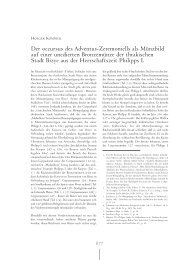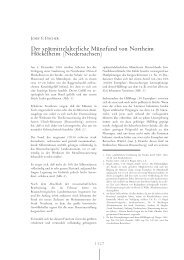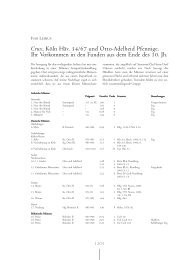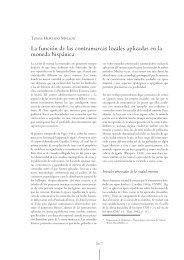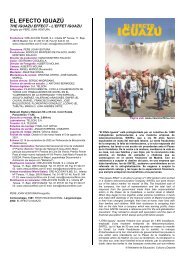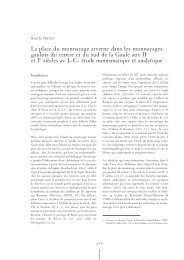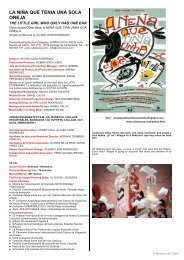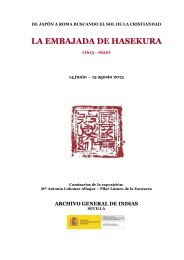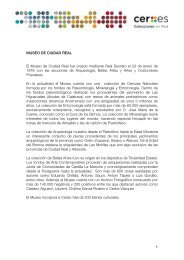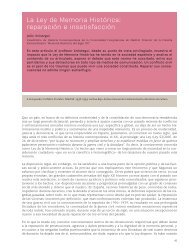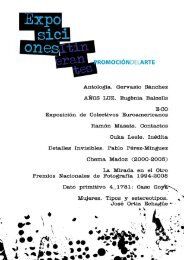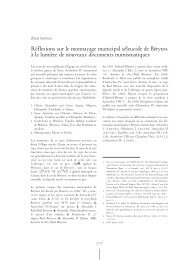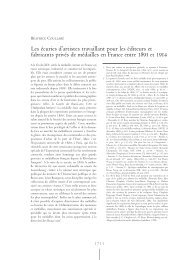Study on the use of subtitling
Study on the use of subtitling
Study on the use of subtitling
Create successful ePaper yourself
Turn your PDF publications into a flip-book with our unique Google optimized e-Paper software.
magazines for cinema enthusiasts and artho<strong>use</strong> cinemas. Even today, foreign language films<br />
account for a very small share <strong>of</strong> <strong>the</strong> cinema market in <strong>the</strong> United Kingdom.<br />
Cultural barriers<br />
Existing studies and surveys show that, in all <strong>the</strong> countries, viewers like <strong>the</strong> audiovisual<br />
translati<strong>on</strong> technique to which <strong>the</strong>y are most accustomed 34 . The preference for dubbing,<br />
<strong>subtitling</strong> or voice-over depends <strong>on</strong> <strong>the</strong> traditi<strong>on</strong> established in <strong>the</strong> country. However, <strong>the</strong><br />
populati<strong>on</strong> <strong>of</strong> each country does not c<strong>on</strong>stitute a uniform whole. Differences <strong>of</strong> appreciati<strong>on</strong> <strong>of</strong><br />
language transfer practices can be identified between inhabitants <strong>of</strong> large cities and those living<br />
in smaller cities, between students and people who have not attended university, and between<br />
pers<strong>on</strong>s who speak <strong>on</strong>e or more foreign languages and those who speak <strong>on</strong>ly <strong>the</strong>ir mo<strong>the</strong>r<br />
t<strong>on</strong>gue.<br />
In countries where <strong>subtitling</strong> and dubbing practices exist side-by-side for box <strong>of</strong>fice releases, <strong>the</strong><br />
subtitled versi<strong>on</strong>s, which resp<strong>on</strong>d to <strong>the</strong> needs <strong>of</strong> a specific public (multilingual and/or cinema<br />
enthusiasts) are primarily released in large cities whereas cinemas in smaller cities choose<br />
dubbed versi<strong>on</strong>s. The survey <strong>of</strong> university students also shows that this category has different<br />
preferences than those <strong>of</strong> o<strong>the</strong>r categories <strong>of</strong> <strong>the</strong>ir fellow citizens 35 .<br />
In a cultural perspective, <strong>the</strong> questi<strong>on</strong> <strong>of</strong> genres also has to be addressed. Overall, in all <strong>the</strong><br />
countries, two genres are <strong>the</strong> excepti<strong>on</strong> to <strong>the</strong> dominant audiovisual translati<strong>on</strong> mode:<br />
documentaries and animati<strong>on</strong>. For documentaries, several techniques can be <strong>use</strong>d: voice-over,<br />
<strong>subtitling</strong> or a mixed technique involving both. Animati<strong>on</strong>s and children's programmes are<br />
screened in dubbed versi<strong>on</strong>s, in cinemas and <strong>on</strong> televisi<strong>on</strong>, in almost all European countries in<br />
order to give pre-school children access to audiovisual works made specifically for this age<br />
group.<br />
Physiological and psychological barriers<br />
The understanding <strong>of</strong> subtitles requires a number <strong>of</strong> pre-requisites 36 , such as <strong>the</strong> ability to read<br />
and specific competences related to <strong>the</strong> speed at which subtitles change <strong>on</strong> <strong>the</strong> screen 37 . If<br />
<strong>the</strong>se pre-requisites are not met, <strong>the</strong> <strong>use</strong> <strong>of</strong> <strong>subtitling</strong> can be a barrier to understanding a film for<br />
certain categories <strong>of</strong> viewers like children, <strong>the</strong> elderly, immigrants who do not master <strong>the</strong><br />
language <strong>of</strong> <strong>the</strong> host country and hearing-impaired or sight-impaired pers<strong>on</strong>s 38 . On <strong>the</strong> o<strong>the</strong>r<br />
hand, in formal learning c<strong>on</strong>texts, <strong>subtitling</strong> can reduce <strong>the</strong> anxiety experienced by foreign<br />
language learners.<br />
34 For an overview, see Yves Gambier, 'Orientati<strong>on</strong>s de la recherche en traducti<strong>on</strong> audiovisuelle", Target<br />
No 18 (2), 2006, pp. 261-293; Jan Baetens, Atom Egoyan and Ian Balfour (Eds), 'Subtitles. On <strong>the</strong><br />
foreignness <strong>of</strong> film', M<strong>on</strong>treal: Alphabetic City and Cambridge, Mass., and L<strong>on</strong>d<strong>on</strong>, Engl.: MIT, 2004.<br />
35 See secti<strong>on</strong> 5.2 above.<br />
36 See Yves Gambier, 'Sous-titrage et apprentissage des langues', Linguistica antverpiensia, Vol. 6, 2007;<br />
Géry d’Ydewalle and I. Gielen, 'Attenti<strong>on</strong> allocati<strong>on</strong> with overlapping sound, image and text', K. Rayner<br />
(Ed.), 'Eye movements and visual cogniti<strong>on</strong>: Scene percepti<strong>on</strong> and reading', New York, Springer Verlag,<br />
pp. 415-427; Espen Seip Blystad, Arnt Maaso (Eds), 'The invisible Text - Subtitling <strong>on</strong> Norwegian<br />
Televisi<strong>on</strong>', Report by IMK Services, Department <strong>of</strong> Media and Communicati<strong>on</strong>, University <strong>of</strong> Oslo, March<br />
2004.<br />
37 Henrik Gottlieb, 'Teksstning et polysemiotisk puslespil', s. i Frandsen, Finn (Ed.), Medierne og sproget,<br />
Aalborg, Aalborg University Press; Arnt Maasø, 'Se-hva-som-skjer!'”: En studie av lyd som kommunikativt<br />
virkemiddel i TV, Oslo, Faculty <strong>of</strong> Humanities, University <strong>of</strong> Oslo, Unipub, 2002.<br />
38 See G. d’Ydewalle and M. Van de Poel (Eds), 'Incidental Foreign-Language Acquisiti<strong>on</strong> by Watching<br />
Subtitled Televisi<strong>on</strong> Programs', Journal <strong>of</strong> psycholinguistic research, Springer, Vol. 28 No 2, 1999; Joselia<br />
Neves, 'Audiovisual Translati<strong>on</strong>: Subtitling for <strong>the</strong> Deaf and Hard-<strong>of</strong>-Hearing', PhD; School <strong>of</strong> Arts,<br />
Roehampt<strong>on</strong> University, 2005.<br />
FINAL REPORT- JUNE 2011 Media C<strong>on</strong>sulting Group -- page 24



